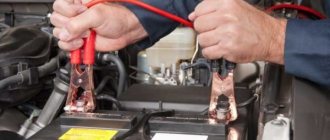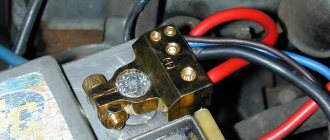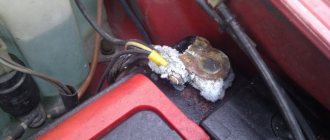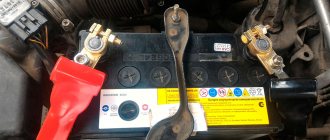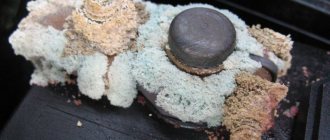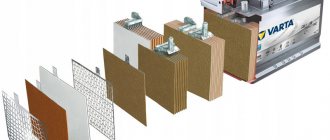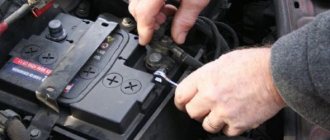Preparing to disconnect the battery
Although the removal and installation procedure is quite a familiar process for all car enthusiasts, you should pay attention to safety rules , how to properly remove the terminals from the battery, in what sequence, how to disconnect the battery so as not to harm the car.
Necessary equipment
If you know which wire to remove from the battery first, disconnecting is not a difficult process, provided you follow certain rules:
- remove the battery cover;
- Use a metal brush to remove accumulated dust;
- determine which key is needed to remove the terminal;
- prepare a screwdriver, a set of keys, usually they are 8, 10 or 13 mm in size.
Safety precautions
It is better to wear gloves when disconnecting the battery. When removing a battery, an experienced driver should always know which terminal to remove first and how to remove the terminals from the battery in order to comply with safety precautions. The vents release hydrogen, which is explosive. A small spark from a short circuit can cause an explosion. It is better to carry out the removal work outdoors or in a ventilated area.
Before turning off the device, you need to carry out a number of mandatory procedures:
- turn off the ignition;
- guaranteed to turn off all electronics;
- close the windows and doors, if the device is located in the trunk, close the hood;
- turn off the mains switch, if there is one;
- decide which terminal should be removed from the battery first;
- when contacts are oxidized, do not hit them with pliers or a hammer, otherwise the plates will be destroyed;
- remove the terminal from the battery with negative polarity, in this case it is necessary to position the negative wire with the connector in such a way that it does not dangle, does not interfere with further actions and cannot return to its original place;
- remove the positive connector;
- After removing the battery, do not throw or hit the battery to avoid liquid leakage inside;
- The removed device cannot be stored at low temperatures so that the plates do not fall off.
The procedure for removing battery terminals for foreign cars is the same as for domestic cars.
IMPORTANT! If damage is detected on the removed battery, further operation is prohibited.
If the terminals are oxidized
Oxidation at the terminal terminals occurs:
- due to a leaky battery case;
- due to a faulty generator giving overcharge.
The oxide forms in the form of a whitish coating, similar to salt, which indicates that it is urgent to take some measures to eliminate this defect. If plaque has accumulated on the battery terminals, it will not be easy to remove the wires from them, and before unscrewing the nuts and bolts, you must first remove the formed oxide.
The easiest way to clean the battery from plaque is with a baking soda solution; it must be applied to the oxidized surface and wait for a while. After the build-up has dissolved, its remnants will need to be thoroughly removed using a clean rag, and only then can you begin to remove the wires.
We recommend: Why is the oil level in the engine low, what could be the consequences?
Another important point is that oxidized deposits accumulate on the inner surface of the battery cable terminals. It must be cleaned, otherwise contact is lost, the engine starts with problems, and the wires get hot.
You can clean oxidized areas using:
- sandpaper;
- WD-40;
- ordinary water and rags.
By the way, with a cloth moistened with water, the plaque can be cleaned effectively; you just need to spare the liquid and repeat the action several times. On the contrary, it is better not to use a metal brush - deep scratches form on soft metal, in which dirt accumulates, causing contact to deteriorate.
Long-term parking: what to remove and is it possible to disconnect one terminal
The battery is hard-wired to the car network. When the ignition is turned off, all consumers still do not turn off. The radio, alarm, and on-board computer take energy from the battery. In a few days, the battery will not be able to discharge. And after a month or more, the charge drops to such an extent that at least a recharge is needed.
To prevent the battery from draining, you need to disconnect the battery. The question arises, which terminal to remove from the battery when parked for a long time.
IMPORTANT! Always remove the negative terminal of the battery. This is done because the minus goes to the car body, and this is a very large inertial mass. After a long period of inactivity, the negative plates dissolve in sulfuric acid on their own. There is no such inertial load on the positive contact.
It would be more correct to remove both terminals on the battery, then it will be isolated from the effects of the car’s electrical equipment.
You can also remove the positive one, but then the car’s network will turn off. The weight of the body will affect the negative terminal, which will lead to faster self-discharge.
Required Tools
In order to connect and disconnect the battery on a car, you need the tools that are presented in the table below.
Table - Tools required to connect and disconnect the battery
| Tools | Note |
| Set of heads | Sizes from “10” to “18” depending on the machine model and terminal type |
| Ratchet | With extension |
| open-end wrench | For unscrewing and tightening terminal fasteners if it is impossible to reach with the head |
| Screwdriver | With straight or cross blade. Necessary for disconnecting some types of terminals |
| Brush | For cleaning dirt and oxidation |
| Sandpaper | For stripping terminals |
We recommend: How to check the variator when buying a car
Disconnecting and connecting battery terminals rarely leads to injury. Despite this, the battery is a chemical source of electricity and poses a certain danger. When working with it, there is a risk of contact with acid from the electrolyte. The voltage at the terminals is usually 12 V, but even this can lead to electrical injury under unfavorable conditions. Therefore, many car owners use protective equipment such as gloves and goggles for reinsurance.
Sequence of actions when connecting the battery
When installing the battery, you need to pay attention to the positive and negative contacts so as not to install the battery the other way around, plus to minus. Those car enthusiasts who do not see the difference in which terminal to put on the battery first can cause damage to their car.
Which terminal should be put on the battery first?
The positive terminal is put on first.
Install the battery in the following order:
- install and secure the battery in its proper place in the car;
- put the positive terminal on the corresponding contact, the order of connecting the battery terminals is in reverse order;
- tighten the fastening nut using a number 10 wrench or a wing nut;
- then put on the negative terminal and tighten the nut.
Instructions for further actions
After installing the battery, you need to check the operation of the on-board electronics. When the battery is removed, all parameters are automatically reset. The problem arises that if the battery is correctly removed and reinstalled, the vehicle will not function.
To configure these systems, many years of experience of motorists suggests the following steps:
- when starting the engine, bring it to normal temperature;
- turn off the engine;
- disconnect the negative contact, after 5 minutes return it to its place;
- do the same with the positive terminal;
- start the engine for 15 minutes, during which time the computer will restore all data;
- after turning it off, all information will be saved;
- to check, start the engine again in the tested mode;
- turn off the ignition, after a few minutes the system will record all parameters.
In order for the car to always be on the move, you need to know the reasons for battery discharge, how to remove the terminals from the battery, which terminal should be removed first from the battery, and in what sequence to connect the battery terminals. Carrying out battery diagnostics will help avoid car breakdowns. With proper maintenance, the battery will last for more than one year.
How to connect a car battery
To connect the battery to the car, you must follow the sequence of actions below.
- Clean the inner surfaces of the wire lugs. It is recommended to use fine-grained sandpaper.
- Clean the battery terminals.
- Connect plus. It is forbidden to connect the negative first. This is due to the fact that a short circuit is possible if the key carelessly touches the car body.
- Before connecting the second terminal, you need to check that the connection diagram is correct and the polarity is not reversed. On some cars, for safety reasons, the tips have different diameters.
- Tighten the nuts securely.
- If there are plastic protective caps, place them on the terminals.
In what order should the battery terminals be connected after charging?
It is recommended to fully charge the battery once or twice a year, even if it is not very discharged. This procedure allows you to restore the battery capacity, thereby extending its life. Full charging is carried out in stationary conditions using a charger.
The battery is removed in exactly the same order as when replacing it. During charging, the sequence of connecting the terminals is the same: first the positive wire is connected, on the charger it is also red, then the negative one. The charging process itself depends on both the charger used and the condition of the battery; the instructions for the device describe all possible operating modes.
Remove the terminal to clear the error
When removing the terminal, another error may occur, which will create even more problems. There are safer ways to reset without further hassle. You can remove one terminal (plus) to cause a short circuit. If the battery is new, most likely nothing will happen. But this method is still not recommended, since in the event of a breakdown there will be nothing to reset.
If it is possible to discharge the battery to zero, it is better to do so, and then sort it out at a service center.
Battery care to increase service life
For long-term and uninterrupted operation of the battery, proper care is required. It consists of cleaning the battery and terminals from dust and moisture, and removing dirt from the ventilation holes. Treatment of fasteners with anti-corrosion agents.
With proper care and proper use, the battery will last a long time and will not require replacement. The main thing is to monitor the condition of the equipment and be especially careful when replacing and installing it.
Learn how to double your battery life in this video:
After you adhere to all these rules and recommendations, choosing and replacing a battery will not be difficult for you. You should not try to avoid this procedure, as it may make further operation of the vehicle easier. After all, failure to comply with the requirements can lead to incorrect operation of your car, and any malfunction during its operation can cause an emergency situation.
Design and types of batteries
The rapid development of technology has also affected the field of car batteries. Gone are the days when only serviceable antimony batteries were available. Today, if a battery needs to be replaced, drivers have plenty to choose from:
- Lead-acid power supplies. The classic type of battery, consisting of a housing in which lead electrodes are installed and electrochemical fluid is filled. The electrolyte reacts with the electrodes when current is supplied to the terminals from an external power source and when a load is connected. The average service life of this type of battery is about 5 years.
- AGM batteries are an improved version of lead-acid batteries. The main difference is the presence of fiberglass wrapping of the electrodes, which prevents them from falling off. They are manufactured using maintenance-free technology and are installed mainly in electric vehicles.
- Gel batteries use a jelly-like electrolyte instead of a liquid electrolyte, which has an order of magnitude less fluidity. This allows you to operate the battery in an inclined position, up to vertical, without the risk of electrolytic fluid leaking.
- Traction batteries differ from the listed analogues in their greater power (currents up to 1000 A and voltage up to 96 V), which allows them to be used as a long-term power source for vehicles.
Removing the BMW E53 battery (pre-styling)
On some cars, the battery is quite difficult to remove, and a lot of work needs to be done to dismantle it. The electric energy storage device of a BMW crossover is located in the trunk, and it is not at all easy to get to. To remove the battery on a German SUV, you must:
- open the very back door, remove all things from the trunk;
- by pressing the button in the rear of the body, remove the lower shelf, under which the spare tire is located;
- disconnect the spare wheel mount, then remove the spare tire from the trunk;
- there is an air suspension compressor under the wheel, it is covered with a casing, so unscrew the nuts securing it;
- after removing the compressor along with the casing, we finally get to the battery, disconnect the negative terminal;
- but that’s not all, then we dismantle the compressor mounting brackets (attached at four points);
- using a wrench and a 10mm socket, unscrew the fastening of the battery itself;
- unscrew the nut securing the positive wire;
- Now the battery can be removed.
On technically complex cars with a large number of different electronics, it is better to trust the removal of the battery to professionals; repairing expensive equipment will cost much more than replacing the battery.
Causes and consequences
A car SLI battery supplies electricity to the vehicle. It is necessary for lighting, ignition, powering electrical appliances and starting the engine.
Batteries require regular maintenance.
To keep the battery in working condition, you should protect it from the cold, regularly clean the contacts from carbonate and deposits, and check the electrolyte level. There are many reasons why it needs to be removed. Among the common ones are:
- emergency charging;
- removal for storage during a long period of non-use of the vehicle;
- battery maintenance;
- replacing batteries or other car and engine parts.
Even if you have a maintenance-free battery and do not need to regularly add distilled water, measure electrolyte levels, etc., you will still have to remove the battery often. For example, for winter storage or emergency charging.
Removing the battery is a simple operation, but before doing it, it is recommended that you familiarize yourself with the instructions and mechanics of the power controller in a specific car brand.
In particular, expensive luxury foreign cars, such as Volvo XC70, Infinity, Lexus, Peugeot, are often equipped with several electronic control units responsible for various functions. The settings of additional power controllers can be reset when the battery is removed, so it is recommended to carry out servicing of such cars at the stations of an official dealer.
In most cases, this is still an easy matter. From cars such as Lada, Matiz, MAZ, Kia Rio, Priora, Chevrolet, and from 80% of other cars, the battery can be easily removed, since the cars have only one battery (we are not talking about the battery, but about something else?) with standard settings that are not reset.
Mid-segment cars, for example, Volkswagen, Hyundai Solaris, Renault Logan, Honda, are often also equipped with special toggle switches that turn off the power system and simplify battery removal.
Safety precautions when removing the battery from a car
The first thing an inexperienced car enthusiast needs to do is find the battery under the hood.
This is a fairly large box with two metal connectors, one of which is most likely covered by a plastic cover. Be sure to turn off the engine before starting work. Check for battery leakage. To protect yourself from sulfuric acid, always wear safety glasses and rubber gloves. If you notice signs of severe leakage and corrosion, it would be wise to contact a professional. Important!
It's connected to the body of the car, and if you take the positive lead out first and accidentally touch any metal part, you'll short out the battery (not to mention a shower of sparks).
Proceed to disconnect the cables. This must be done with caution, otherwise you may be in for an unpleasant “surprise”. There are two cables: positive and negative. Always remove the negative one first.
With the negative cable disconnected, go to the positive cable. As a rule, it is usually red, and negative is black. However, it is better to check the battery label to be on the safe side. Now you can remove the battery from its place. Keep in mind that the battery is quite heavy. If you are installing a new one, then you should take the old one to an authorized recycling center. However, if you're just planning on recharging, you can take the opportunity to clean the terminals with a wire brush. Do the same with the cables.
Now it's time to put the new battery or the old, recharged one back into place.
A good finishing touch would be to apply a special lubricant to the terminals to prevent further corrosion. Now you need to start the engine to make sure everything is in order.
Attention! You will have to connect everything in reverse order: after placing the battery in place and securing it, connect the positive cable first, and then the negative.
Self-discharge and leakage currents
When a rechargeable lithium battery is used as a storage component for indoor energy harvesting, the battery leakage current cannot be ignored, especially in ultra-low power applications. It is generally believed that the leakage current in a lithium battery is in the small µA range.
An experimental method for measuring it is proposed by applying a µA charge to a stabilized battery with post-charging to observe the change in voltage at the terminals. When the applied charging current is greater than the leakage current, a positive sign (increase in terminal voltage) may be observed. Otherwise – negative. By gradually changing the charging current, using a search algorithm in successive approximation, the leakage current will finally converge with the applied charging current.
Convergence occurs after changing sign in two successive search procedures, demonstrating that charging currents approach the leakage current in both directions. The approximation accuracy can be improved by adjusting the number of sign changes in the successive approximation search algorithm. The proposed method allows the full capacity of a rechargeable lithium battery to be used with ultra-low power consumption.
What you need to install the battery in the car
Before installing the battery, you need to prepare the necessary tools and consumables for installation work.
Depending on the car model, technical condition of the battery, and the condition of the terminals, the standard battery installation kit includes:
- open-end or socket wrenches for 10 and 13 (other options are possible);
- pliers;
- assembly knife (for stripping wires);
- sandpaper (fine and coarse - for cleaning contacts and terminals);
- special means for treating contacts and terminals in order to prevent their corrosion (you can use lithol, grease or silicone grease in the form of a spray);
- personal protective equipment (see next section);
- multimeter for monitoring battery charge voltage.
